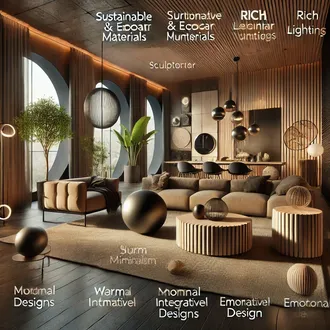Transcription The decorative idea
As we saw in the previous presentation, the task of the interior decorator is to help people find wellbeing, beauty and harmony in the places they inhabit. To achieve this, they must strive to discover the dreams, aspirations and tastes of their clients; in addition, they must study the variables of functionality, aesthetic elements, available space and economic resources. And once all these elements have been weighed, offer the client a set of ideas that are attractive to them.
This means that it is not possible to satisfy the expectations of each client by following "decorative models", nor by offering "decorative recipes"; since each client demands a different decoration. The constant generation of ideas to satisfy each one is a tough challenge for the decorator, but at the same time it gives him the possibility to channel all his creative energy, his intellect and his original thinking, which are the fundamental pillars to achieve outstanding results in his professional life.
What is the decorative idea?
The decorative idea is the integrative mental representation of everything that is to be achieved and everything that needs to be done from conception to completion of the decorative project. It allows to maintain the connection, order and harmony between all the elements involved in the decorative process, and is the result of observation, reasoning, application of the intellect, emotional experience and creativity of the decorator.
Without a comprehensive and well-defined decorative idea, which guides and organizes the whole process and contemplates even the smallest details, the decoration will be deficient, with deficiencies or excesses that show imbalances, antagonisms or lack of connection between the different elements used.
How to develop creative decorative ideas?
Only some people are born with innate aptitudes to generate ideas or concepts that produce original solutions; therefore, most of the successful creators have achieved their results by training their brain in the practice of creative work. You can achieve them too, you just have to put into practice the following recommendations and you will see how more innovative ideas will begin to occur to you every day:
- Develop the ability to observe, that is the fundamental premise for learning how to decorate. Observing is not the same as seeing, observing is looking carefully and feeling, analyzing, reflecting, becoming aware of the sensations produced by the place, the objects, the light, the colors, the words, the client's behavior, etc., to draw conclusions and establish connections that help us find creative solutions.
- Study and investigate the work and trajectory of other decoration professionals. This will allow you to learn about other criteria, other theories and elements used by decorators from different periods, cultures, countries and regions; which will stimulate your imagination and creative skills.
- You should not hide your ideas for fear of not being accepted, the worst enemy of creativity is fear. Let your ideas flow, enrich them, recycle them and put them into practice without falling into a routine. Page break
Aesthetic elements to take into account to set up the decorative idea
- The space we have and the use we are going to give it. The first thing to consider is whether the dimensions of the space are close to those required for its purpose, or if we should use some decorative resources to achieve appearances of more or less space.
- Amount of natural light available and the way in which this affects each of the places of the room. To correct the insufficiencies or excesses of light during the schedules of the day, we must take into account the use of light or dark colors in the walls and ceilings and the use of curtains, net curtains, etc.
- The general atmosphere that we want to give to the room. To achieve the atmosphere we have to select the basic predominant color in the room and the different tonalities that we must create combining colors, illumination, quantities and disposition of objects.
- Select a predominant decoration style or organically combine different current trends. In this aspect we must also define the shapes, sizes and colors of the furniture and other decorative objects that are in accordance with the aesthetic trends of the moment and the tastes of the client.
- Distribution of all the elements in the room. The first questions to be taken into account at this point are practical, for example: that furniture and other objects do not interfere with the circulation in the room. Then the distribution will be continued taking into account the aesthetic reasons.
- Finally, other decorative aspects should be considered, such as the texture of surfaces, the use of localized artificial light, carpets, and so on. Page break
Other factors to take into account to configure the decorative idea
- Economic: The budget available to the decorator will allow him to work with more or less decorative variations. If the budget is scarce, his task is much more difficult, since the options to solve the decorative tasks are reduced; on the other hand, when the budget is sufficient, each new challenge can be given the appropriate solution.
- Particularities of the client: The decorative work should be oriented to satisfy all the client's aspirations, therefore special attention should be paid to all their requests and also to other manifestations that reflect their personality, their aspirations, their dreams and help us to unravel their real needs.
- Natural factors: The natural factors that most influence the decorative project are temperature and lighting. For example, in a warm region it would not be convenient to use the red range of colors, nor carpets, curtains and upholstered furniture; while in cold regions, blue-green tones and metallic furniture should be avoided.
On the other hand, in places where the sunlight and the orientation of the room favor the entrance of intense light, curtains and colors should be used to avoid glare, however, in places where cloudy skies and snow predominate, it is advisable to use light and bright colors on the walls and the moderate use of curtains and net curtains.
idea




